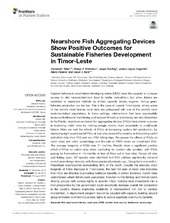| dc.contributor.author | Tilley, Alexander | |
| dc.contributor.author | Wilkinson, Shaun P | |
| dc.contributor.author | Kolding, Jeppe | |
| dc.contributor.author | Lopez-Angarita, Juliana | |
| dc.contributor.author | Pereira, Mario | |
| dc.contributor.author | Mills, David J | |
| dc.date.accessioned | 2020-06-17T09:46:06Z | |
| dc.date.available | 2020-06-17T09:46:06Z | |
| dc.date.issued | 2019-08-13 | |
| dc.Published | Tilley, Wilkinson, Kolding J, Lopez-Angarita, Pereira, Mills DJ. Nearshore fish aggregating devices show positive outcomes for sustainable fisheries development in Timor-Leste. Frontiers in Marine Science. 2019;6:487 | eng |
| dc.identifier.issn | 2296-7745 | en_US |
| dc.identifier.uri | https://hdl.handle.net/1956/22674 | |
| dc.description.abstract | Capture fisheries in small island developing states (SIDS) have the capacity to increase access to vital micronutrient-rich food to tackle malnutrition, but when fishers are restricted to nearshore habitats by limited capacity (boats, engines, fishing gear), fisheries production can be low. This is the case of coastal Timor-Leste, where some of the world’s most diverse coral reefs are juxtaposed with one of the world’s most undernourished populations. In these settings, interventions that have successfully improved livelihoods from fishing and reduced threats to biodiversity are rare. Elsewhere in the Pacific, nearshore anchored fish aggregating devices (FADs) have shown success in improving catch rates by making pelagic stocks more accessible to small-scale fishers. Here we test the effects of FADs at increasing capture fish production, by deploying eight experimental FADs at four sites around the country and recording catch and effort data from FAD and non-FAD fishing trips. We assess the effects of FADs on catch rates and catch assemblage and the rate of 100% return on investment (RoI ). The average longevity of FADs was 11 months. Results show a significant positive effect of FADs on catch rates when controlling for random site variation, with FADs paying for themselves in ∼5 months or less at three out of four sites. Across all sites and fishing types, 63 species were identified, but FAD catches significantly reduced overall assemblage diversity, with three species (Sardinella spp., Decapterus macarellus, Rastrelliger brachysoma) representing 96% of the catch. Despite the relatively short longevity of FADs deployed in Timor-Leste, the fast RoI seen at most sites indicates that FADs are effective in providing livelihood benefits in certain locations. Catch rates were highest where fishers were specialized, invested in FAD fishing, and formed catch sharing groups with access rights to specific FADs. National level investment into a FAD programme by the government could realistically increase overall fish production in the country, thereby improving availability of micronutrient rich fish to combat malnutrition. A deployment program should be coupled with capacity building around group formation and defining access rights to ensure equitable community benefits. | en_US |
| dc.language.iso | eng | eng |
| dc.publisher | Frontiers | en_US |
| dc.rights | Attribution CC BY | eng |
| dc.rights.uri | http://creativecommons.org/licenses/by/4.0/ | eng |
| dc.title | Nearshore fish aggregating devices show positive outcomes for sustainable fisheries development in Timor-Leste | en_US |
| dc.type | Peer reviewed | |
| dc.type | Journal article | |
| dc.date.updated | 2020-01-02T12:20:15Z | |
| dc.description.version | publishedVersion | en_US |
| dc.rights.holder | Copyright 2019 Tilley, Wilkinson, Kolding, López-Angarita, Pereira and Mills | en_US |
| dc.identifier.doi | https://doi.org/10.3389/fmars.2019.00487 | |
| dc.identifier.cristin | 1727245 | |
| dc.source.journal | Frontiers in Marine Science | |

